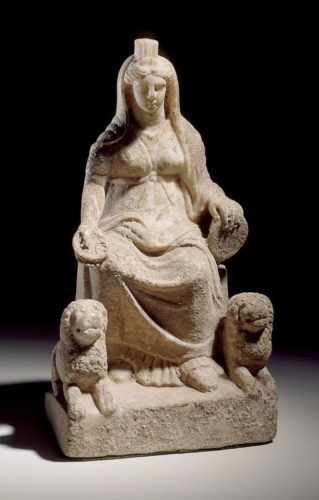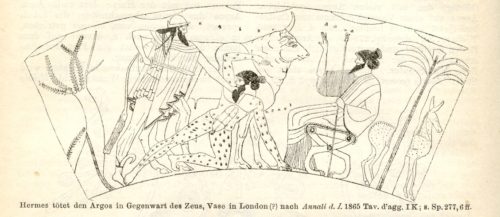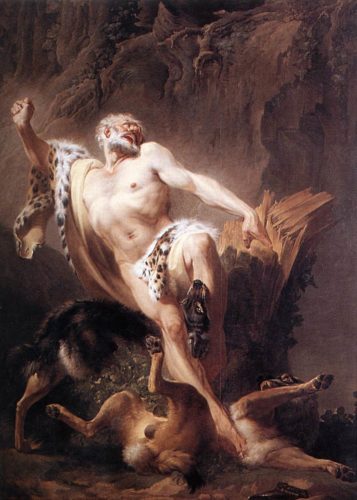 The fourth century C.E. Neoplatonist Sallustius, a friend of the Roman Emperor Julian (who revoked Christianity’s status as state religion and attempted to revive polytheist worship), wrote in On the Gods and the Cosmos that the myths told in religious initiations “never happened, but always are,” and that “as the myth is in accord with the cosmos, we for that reason keep a festival imitating the cosmos, for how could we attain higher order?” (section 4) Sallustius wrote that myths which mix both psychic and material interpretations particularly “suit religious initiations, since every initiation aims at uniting us with the world and the gods.”
The fourth century C.E. Neoplatonist Sallustius, a friend of the Roman Emperor Julian (who revoked Christianity’s status as state religion and attempted to revive polytheist worship), wrote in On the Gods and the Cosmos that the myths told in religious initiations “never happened, but always are,” and that “as the myth is in accord with the cosmos, we for that reason keep a festival imitating the cosmos, for how could we attain higher order?” (section 4) Sallustius wrote that myths which mix both psychic and material interpretations particularly “suit religious initiations, since every initiation aims at uniting us with the world and the gods.”

Kybele [Public Domain]
There is also a cave in at Hierapolis in Phrygia, of which Daniel Ogden writes in Greek and Roman Necromancy: “The … fumes supposedly killed all but eunuch-priests (galli) and mystery-initiaties. As an initiate, Damascius ventured into the cave in the sixth century A.D., and subsequently dreamed that he was the gallus Attis, that he had been ordered by the mother of the gods to celebrate the Hilaria, and that he had been delivered from Hades.” (26) Damascius’s experience shows that even for non-galli, the myth had the power to re-enact itself in the realm of underworld-connected caves and dreams.
The connections between myth and mystery initiation run even deeper, however. Following Gregory Nagy, Richard P. Martin writes in “The Myth Before Myth Began:”
The root underlying the noun form muthos is that found in the Greek verb muô meaning ‘to close’ the eyes or mouth. From the same root we have the words mystêrion (mystery) and mystês (initiate), in both of which the notions of closure, and of being closed off or excluded, are operative. (4)
Furthermore, in Homeric poetry, μῦθος had the connotation of “authoritative utterance,” specifically a “unitary speech-act term comprising subcategories of rebuke, command, and recollection.” (2) Thus, it should come as no surprise that myths do indeed continue to unify speech and action, to violently reenact themselves in the material world and then to be recollected through storytelling.

Hermes slaying Argos, rawing of fifth-century B.C.E. Athenian vase [Public Domain]
Argeiphontes
Argos was a hundred-eyed giant, surnamed Panoptes: all-seeing. According to Ovid’s Metamorphoses, Zeus transformed his lover Io into a milk-white heifer in the hopes of deceiving Hera, but when Hera asked for the cow to be given to her as a gift, Zeus acquiesced. Hera then set Argos as a guard over Io.
Argos was well-suited to the task, for he closed only two of his eyes at a time, “whilst all the others kept on watch and guard. Whichever way he stood his gaze was fixed on Io—even if he turned away his watchful eyes on Io still remained.” The Panopticon prison of Jeremy Bentham, much discussed by Michel Foucault in Discipline and Punish, is named after Argos Panoptes, for it operates by the principle that the prisoner never knows when they are being watched, and thus must regulate their own behavior as if they were being watched at all times.
Zeus, unwilling to act openly himself, sent his son Hermes to liberate Io. In Ovid’s version, Hermes lulls Argos to sleep with a long story and a touch of his magic wand, then kills Argos with his sword: “and one night filled his hundred eyes.” Henceforth, Hermes was known by the epithet Argeiphontes, “slayer of Argus.”
The helicopter program of Oakland Police Department is also named ARGUS (Aerial Reconnaissance Ground Unit Support). But what happens when you name your helicopter after the bad guy from a Greek myth, especially when you use it to surveil and terrorize the black and brown communities of Oakland, California?
In October 1973, the August Seventh Guerrilla Movement (named for the date of the martyrdoms of Jonathan Jackson, James McClain and William Christmas, whom I wrote about in “Black August”) shot down ARGUS with “two .30-caliber carbine automatic rifles fired from stationary positions on the ground at the armed copter spying on the city from an altitude of about 500 to 600 feet.” The group had previously demanded the release of the San Quentin Six by Sept. 7. In their claim of responsibility, they declared that the downing of the helicopter was a response to the failure of the Department of Corrections to respond to their ultimatum.
Such was the fate that overtook Milo

Milo of Croton, Joseph-Benoît Suvée. [Public Domain]
He came across in the land of Crotona a tree-trunk that was drying up; wedges were inserted to keep the trunk apart. Milo in his pride thrust his hands into the trunk, the wedges slipped, and Milo was held fast by the trunk until the wolves – a beast that roves in vast packs in the land of Crotona – made him their prey. Such was the fate that overtook Milo. (6.14.8-9)
Far-right internet troll Milo Yiannopoulos attempted to speak at UC Berkeley on Feb. 1, 2017. His talk was shut down by masked individuals who smashed windows of the building he was inside and lit a light generator on fire, engulfing a nearby tree in flames as well.
As I discussed in “War and the Wild Hunt(s),” the scholar Otto Höfler hypothesizes that “the Wild Hunt was possibly the image of brotherhoods that consisted of masked warriors. The mask permitted them to be identified with the dead.” Furthermore, Claude Lecouteux draws parallels between these war bands and “the Latvian werewolves, the name of a secret fraternity of men who could cast Doubles who would fight the wizards who had stolen the seeds.”
The attention caused by “militant direct action” led to the exposure of comments Milo had made about pedophilia, which in turn led to the cancellation of his book deal, the rescinding of his invitation to speak at a conservative conference, and his resignation from Breitbart, where he had been a senior editor. It was the wolves who drew first blood, but it turns out that when the smell of blood is in the air, trolls are cannibals too.
Michael Israel: You Are History. You Are Legend.

Michael Israel. [Photo Credit: Dr Partizan]
Michael’s friend Andee Sunderland recalls that Michael was able to see spirits, and that they reminded him of the reasons why he fought:
At the height of Sacramento’s Occupy movement, he’d become friends with an older woman experiencing homelessness. When she died on the streets, it was a gnawing revelation. “One night Mike was driving home and he started seeing her appear to him,” Sunderland remembers. “He’d always seemed kind of haunted to me. … I think during Occupy he was really affected by the terrible things going on in the world.”
Michael Israel was also an avid student of revolutionary history, tracing his lineage back to the Spanish Civil War:
In 2012 Israel met Delmer Berg, one of the last living survivors of the Abraham Lincoln Brigade, a volunteer force of Americans that fought in the Spanish Civil War. For Israel, meeting Berg brought a legacy of resistance to life. Later, when Berg passed away, Israel expressed his feelings in a social media post. “RIP Del,” Israel wrote. “You are history. You are legend.”
Now it is Michael who is history, who is legend. Legends, like myths, are lived and are alive, and they grant immortality to those who enact them.
Michael was present at the June 26, 2016 battle between neo-Nazi skinheads and antifascists at the California state capitol building in Sacramento. In response, YPG fighters in Rojava posted a photograph in which they held up the red and black Anti-Fascist Action flag. Antifascists like Michael Israel have traveled to Rojava to fight with the YPG against Daesh, and the Kurds have reciprocated their solidarity.

YPG fighters holding Antifa flag. [Photo Credit: It’s Going Down]
Animism
Sallustius attributes the category of myth that he calls “material” to the Egyptians, among others: “they call the earth Isis, moisture Osiris, heat Typhon, or again, water Kronos, the fruits of the earth Adonis, and wine Dionysus.” Sallustius, being a Neoplatonist, is highly contemptuous of this tendency: “To say that these objects are sacred to the gods, like various herbs and stones and animals, is possible to sensible men, but to say that they are gods is the notion of madmen – except, perhaps, in the sense in which both the orb of the sun and the ray which comes from the orb are colloquially called ‘the sun.'”
Sallustius concedes that like the ray of a sun, the “various herbs and stones and animals” do contain divine essence. He also describes “mixed” myth as being precisely a blend of psychic and material interpretations, so despite his disdain, he does not dismiss the material interpretation of myth entirely.
For animists, however, the understanding that “various herbs and stones and animals” are alive and enspirited in and of themselves is foundational. We find the recognition of animism in stories such as Sigurd learning the speech of birds after tasting the blood of the dragon Fafnir: “when the heart-blood of the worm touched his tongue, straightway he knew the voice of all fowls and heard withal how the wood-peckers chattered in the brake beside him.”
![1) Sigurd tasting the dragon's blood. 2) The birds speaking to Sigurd. [Public domain]](https://wildhunt.org/wp-content/uploads/2017/03/Sigurd-500x233.jpg)
1) Sigurd tasting the dragon’s blood. 2) The birds speaking to Sigurd. [Public domain]
Before his house there was an oak, in which there was a lair of snakes. His servants killed the snakes, but Melampos gathered wood and burnt the reptiles, and reared the young ones. And when the young were full grown, they stood beside him at each of his shoulders as he slept, and they purged his ears with their tongues. He started up in a great fright, but understood the voices of the birds flying overhead, and from what he learned from them he foretold to men what should come to pass. (Apollodoros, Bibliotheka 1.9.11)
According to both Herodotos and Diodoros Sikeliotes, Melampous introduced the name of Dionysos to the Greeks from the Egyptians, reinforcing Sallustius’s association of Egypt and animism, and also brought the very myths of the gods themselves: “Melampos also, they say, brought from Egypt the rites which the Greeks celebrate in the name of Dionysos, the myths about Kronos and the war with the titans, and, in a word, the account of the things which happened to the gods.” (Diodoros Sikeliotes 1.97.4)
Melampous uses his ability to understand the speech of animals to foretell the collapse of a roof eaten by worms and termites, and to heal the infertility of Iphiklos:
Having sacrificed two bulls and cut them in pieces he summoned the birds; and when a vulture came, he learned from it that once, when Phylakos was gelding rams, he laid down the knife, still bloody, beside Iphiklos, and that when the child was frightened and ran away, he stuck the knife on the sacred oak, and the bark encompassed the knife and hid it. He said, therefore, that if the knife were found, and he scraped off the rust, and gave it to Iphiklos to drink for ten days, he would beget a son. (Apollodoros, Bibliotheka 1.9.12)
Animism necessitates a different worldview, one which recognizes that even the inadvertent the wounding of an oak can lead to the infertility of the one who wielded the knife, that vultures and woodpeckers and worms have important information to tell us, that saving baby snakes can lead to the prophetic gift.

James Leroy Marker. [Photo Credit: Sabal Trail Resistance]
A Lover of the Earth
James “Jim” Leroy Marker, pictured above holding an alligator in front of a manatee statue and smiling widely, clearly understood these truths—and the only way to understand animism is through experience, not through academic theory. Sabal Trail Resistance writes, “We have learned that he was known by friends as a lover of the Earth and humanity, that he was a military veteran, that he participated in environmental/social advocacy, and that he was a father.”
Religiously, Marker was “a missionary to a church in the Everglades serving people who struggle with recovery from drugs and alcohol,” and a friend described him as having decided “that he needed to do God’s work, to help people.” He used to run an extension cord from his RV to a homeless camp, and “if anyone had a big reptile in their yard, ‘like a boa constrictor or an alligator, he’s the one you call.'”
On Feb. 26, 2017, Marker used a rifle to sabotage a Sabal Trail pipeline construction site, a pipeline in Florida that has provoked a widespread campaign of resistance. Despite the local sheriff admitting that “no law enforcement officer was injured or fired at,” Marker was shot and killed by sheriff’s deputies. According to Sabal Trail Resistance, he may have timed his action in coordination with a call for indigenous solidarity:
It is believed that he may have chosen the date and location to coincide with a call to action that STR announced to honor the anniversary of the 1973 Wounded Knee Stand-off on the Pine Ridge Reservation and to stop the pipeline from going in the ground through the wetlands and endangered species habitat of Halpata Tastanaki Preserve (a site named after a Seminole leader of the armed resistance that fought U.S. invasion of indigenous communities in the mid-1800s.)
In the struggle against the Dakota Access Pipline (DAPL), the Sacred Stone Camp writes, “When we refer to the pipeline as a black snake, we are referencing an old Lakota prophecy that speaks of a black snake (zuzeca sape) crossing the land, bringing with it destruction and devastation.” Clearly, the struggle against pipelines, whether in Florida or on Lakota and Dakota land, is one of mythic dimensions. As the tales of Sigurd and Melampous show us, some snakes and alligators should be saved, but those of monstrous proportions, such as Fafnir or pipelines, should be killed.
In the downfall of ARGUS, we see the myths of the gods, reenacted. In the end of Milo’s career, and in the struggle of Michael Israel, we see immortalized the legends of the dead, the warriors, and the wolves. In the life and death of James Leroy Marker, we see the sacred truths of the land itself expressing themselves. In all of the Three Kindreds, we find eternal recurrence.

Nietzsche Stone, Switzerland [Photo Credit: Katja Seeliger]
Eternal Recurrence
The concept of eternal recurrence is said to have come to Nietzsche while he was walking along the banks of Lake Silvaplana in Switzerland, when he was struck by inspiration at the sight of a titanic pyramidal rock. He expressed it thus:
What if some day or night a demon were to steal after you into your loneliest loneliness and say to you: “This life as you now live it and have lived it, you will have to live once more and innumerable times more; and there will be nothing new in it, but every pain and every joy and every thought and sigh and everything unutterably small or great in your life will have to return to you, all in the same succession and sequence – even this spider and this moonlight between the trees, and even this moment and I myself. The eternal hourglass of existence is turned upside down again and again, and you with it, speck of dust!”
Would you not throw yourself down and gnash your teeth and curse the demon who spoke thus?… Or how well disposed would you have to become to yourself and to life to crave nothing more fervently than this ultimate eternal confirmation and seal?
If the life of mortals is subject to eternal recurrence, how much more so the living myths, the “authoritative utterances,” the “unitary speech-acts,” the bare bones of life and death and peace and war and truth and falsehood and body and soul? And with them, Dionysos, Zagreus, and the Orphikoi.
In the words of Sallustius, “May these explanations of the myths find favour in the eyes of the gods themselves and the souls of those who wrote the myths.” This article is dedicated to James Leroy Marker and Michael Israel. May they rise in power.
* * *
The views and opinions expressed by our diverse panel of columnists and guest writers represent the many diverging perspectives held within the global Pagan, Heathen and polytheist communities, but do not necessarily reflect the views of The Wild Hunt Inc. or its management.
The Wild Hunt is not responsible for links to external content.
To join a conversation on this post:
Visit our The Wild Hunt subreddit! Point your favorite browser to https://www.reddit.com/r/The_Wild_Hunt_News/, then click “JOIN”. Make sure to click the bell, too, to be notified of new articles posted to our subreddit.
Thanks for sharing this fascinating piece on the recurrence of myth – something I’m also exploring with the Brythonic myths. I hadn’t heard of the story of Argos, Panoptes and Argos’s death at the hands of Hermes Argeiphontes before and hadn’t linked it to the Panopticon let alone the ARGUS helicopters. Fascinating and unnerving. Also thank you for sharing the stories and honouring the lives and deaths of James Leroy Marker and Michael Israel. I can tell a lot of research and thought has gone into this.
Thank you!
Your exploration of the recurrence of Brythonic myths in The Broken Cauldron is very powerful.
Pingback: TWH: Animism and the Eternal Recurrence of Myth | Heathen Chinese